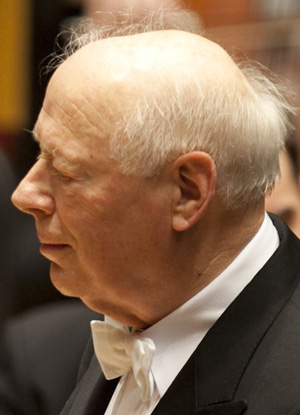Bernard Haitink charms Chicago Symphony with twin beauties from Schubert and Mahler
Review: The last-minute cancellation by violinist Frank Peter Zimmermann prompted Haitink to begin his two-week CSO residency with a magical pairing of Schubert’s Fifth and Mahler’s Fourth Symphonies. *****
By Lawrence B. Johnson
The extraordinary clarity that conductor Bernard Haitink brought to Mahler’s Fourth Symphony, in his concert with the Chicago Symphony Orchestra on Thursday night at Orchestra Hall, seemed to commence with the very opening measures of the work. But in fact that mesmerizing transparency had its origin still further back, in the gossamer-like performance of Schubert’s Symphony No. 5 that opened the program.
Schubert’s graceful little symphony, which pays unequivocal tribute to Mozart, wasn’t even part of the program’s original plan. Haitink pressed it into service when violinist Frank Peter Zimmermann, who was reported to be suffering from bronchitis, canceled his scheduled appearance with the CSO to play Berg’s Violin Concerto. It was an inspired substitution, a miniature counterpart of the most becalmed, linear and finely-wrought of all Mahler’s symphonies.
The Schubert Fifth Symphony holds a special place in my affections, not only because of its inherent charms but also because the first time I ever heard it live was the first time I attended a Chicago Symphony concert, a performance in the late 1960s under the CSO’s music director at the time, Jean Martinon. Afterward, I marched directly to that bygone treasure house Rose Records and purchased the CSO’s recording with Fritz Reiner – the one with the robin’s nest of unhatched eggs on the jacket. The marquee piece on that LP was, of course, Schubert’s “Unfinished” Symphony.
Even at a distance of 45 years, I’m sure that Schubert Fifth with Martinon bore faint resemblance to Haitink’s on Thursday night, if only because the orchestra Martinon led was perhaps twice the size of the chamber ensemble arrayed before Haitink. Schubert’s modest choir of French horns, oboes and bassoons in pairs plus a single flute implies a salon-size string complement, and that’s what Haitink employed to magical effect. This was lighter-than-air Schubert, buoyant, animated, sparkling.
And indeed with the first burbling tune that wells up at the start of Mahler’s Fourth Symphony, the orchestra now hugely expanded, one had a distinct sense of Schubert redux, though writ large.
Despite their increased numbers, the CSO strings delivered Mahler’s gently effervescent phrases with the same poise and finesse that kept the Schubert from ever touching earth. And one became quickly aware that Haitink, long one of the world’s preeminent Mahler conductors, had brought the same precision and balance to Mahler’s vast complement of woodwinds and brasses that he achieved with that septet in Schubert.
Haitink’s perspective on the Mahler Fourth was altogether serene, even bucolic. This is the most pacific and linear of Mahler’s symphonies, and Haitink went with that pervasive tranquility. Which is not to say the performance was anything less than vibrant. Great energy of deceptive urgency sprang from the conductor’s meticulous attention to interior rhythmic inflection and a dynamic play of textures, sound layered on sound.
The benignly devilish second movement, outwardly a scherzo, felt more like an intermezzo with piquant accents. Here, as in the opening movement, elegantly counterpoised woodwinds answered radiant strings. Concertmaster Robert Chen, switching between his conventionally tuned violin and a second, “mistuned” instrument that Mahler calls for, provided the scherzo with the rakish edge that’s about as close as this work comes to Mahler’s characteristic irony and conflict.
The Fourth Symphony is essentially unshadowed, but not without a profound center: the double variations that form the third movement, building from the low strings’ gently rocking pizzicato through a brilliant and yet deeply reflective narrative. Here, Haitink’s sure instinct for tempo, and an uncanny knack for shifting the pace exactly the right moment, carried this opulent music forward with an ease that tumbled into enchantment. In no small measure, the source of that wonder was the blazing sound of brasses.
In the finale’s shimmering evocation of a child’s view of heaven, soprano Klara Ek imbued innocence with an angelic voice, describing the boundless wonders of that place beyond earthly compare – including its music. Yet, in summoning from the CSO a final outpouring of earthly brilliance, Haitink capped a Fourth Symphony of divine luminosity.
Related links:
- Haitink’s CSO concerts continue through Oct. 28. Click here for ticket info.
- Haitink rehearsing: Here’s a rare 1965 recording of Haitink rehearsing Mahler’s 2nd Symphony with the Amsterdam Concertgebouw.
- Haitink teaching other conductors: Masterclass on Brahms 3rd Symphony.
- In case you missed it: Here’s Haitink conducting the final movement of Mahler’s 4th Symphony with another orchestra — the Royal Concertgebouw — and soprano Christine Schäfer.
Photo captions and credit: Bernard Haitink in performance with the Chicago Symphony Orchestra. (Photos by Todd Rosenberg.)
Tags: Bernard Haitink, Chicago Symphony Orchestra, Franz Schubert, Gustav Mahler, Haitink, Mahler, Schubert



